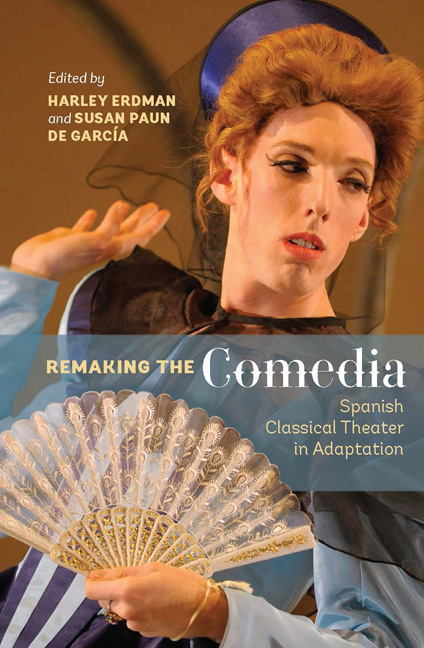Book contents
- Frontmatter
- Contents
- Illustrations
- Contributors
- Preface
- Note to the Reader
- Acknowledgements
- PART I THEORIZING
- 1 Terms and Concepts: The Adaptation of Classical Texts for the Stage
- 2 “Los senderos que se bifurcan:” Adaptation, Appropriation, and the Proliferation of Possibilities
- 3 Interpretative Directing Games for the Golden Age Repertory
- 4 Re-Make, Re-Mix, Re-Model
- PART II SURVEYING
- PART III SPOTLIGHTING
- PART IV SHIFTING
- Play Titles Cited
- Works Cited
- Index
4 - Re-Make, Re-Mix, Re-Model
from PART I - THEORIZING
Published online by Cambridge University Press: 05 December 2015
- Frontmatter
- Contents
- Illustrations
- Contributors
- Preface
- Note to the Reader
- Acknowledgements
- PART I THEORIZING
- 1 Terms and Concepts: The Adaptation of Classical Texts for the Stage
- 2 “Los senderos que se bifurcan:” Adaptation, Appropriation, and the Proliferation of Possibilities
- 3 Interpretative Directing Games for the Golden Age Repertory
- 4 Re-Make, Re-Mix, Re-Model
- PART II SURVEYING
- PART III SPOTLIGHTING
- PART IV SHIFTING
- Play Titles Cited
- Works Cited
- Index
Summary
I began my relationship with the plays of the Spanish Golden Age thirty-two years ago, and we have been conducting a passionate affair in public and in private ever since. After putting these plays on stage for paying audiences, I have come to know that the best of them, if seen and respected for what they are, work as well in performance as any of the more established texts of the European classical repertory. I've learnt that these plays have a unique voice and form, that actors love bringing them to life in rehearsal and on stage, that audiences are inspired and delighted watching them, and that they still have something useful and instructive to tell us about ourselves and how we live our lives. The plays of the Spanish Golden Age are finding a place in the repertory of the British theatre and are gaining a reputation in places where they have not previously been performed. The awareness of the plays outside the Hispanic world is growing.
My First Re-Make
My first meeting with the plays took place in the John Rylands University Library, Manchester, in October 1979. Our meeting reverberated with synchronicity. I was a first-year undergraduate in my first term, researching the work of Joan Littlewood, and in “Joan's Book” I discovered that she had directed Fuenteovejuna by Lope de Vega, with her radical company in the east end of London in 1956.
Fuente Ovey … what? Low pay de … who? I was a student of drama, not Spanish; the words were exotic and intriguing. I dropped Joan's thick tome, and minutes later I was flicking through faded mint-green cards in a lacquered oak cabinet, where I found the details of a translation of Fuente, written in blue-black ink in an elegant copperplate hand. The card directed me to a corner of the library I'd never visited: Four Plays by Lope de Vega, translated by Garrett Underhill, published by Scribner of New York (1936), reprinted by the Hyperion Press (1978).
- Type
- Chapter
- Information
- Remaking the ComediaSpanish Classical Theater in Adaptation, pp. 33 - 42Publisher: Boydell & BrewerPrint publication year: 2015

